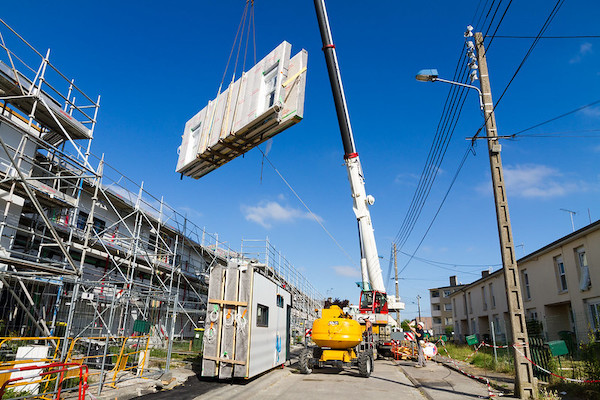By Retrofitting the Way We Think About Renovating Homes
Looking back on 2020, despite COVID-19 there were some positive storylines… among them, the fact that the European Union declared the ambitious goal of becoming climate neutral by 2050. And as a steppingstone in that direction, the EU also announced that it intends to cut greenhouse gas emissions by 55% (compared to 1990 levels) by 2030.
Having drawn a proverbial line in the sand, the unavoidable question facing the EU now is: how do you make the jump from setting lofty goals to actually achieving them?
Making Waves
To some extent, the European Commission has already begun to answer that question with its Renovation Wave Strategy of doubling renovation rates over the next decade. The motivation for ramping up building retrofits has been driven by numbers that are impossible to ignore: buildings in the EU account for 40 percent of energy consumption and 26 percent of its greenhouse gas emissions. So even if Europe were to put a big push on converting its coal fired plants to wind turbines and other alternative energy sources… without taking bold steps to make buildings significantly more energy efficient, the continent would still fall well short of its GHG reduction goals.
As stated on the New Europe website, the benefits to be realised by transforming existing housing stock into energy efficient homes are far reaching… starting with a significant reduction in greenhouse gases. But also, improved quality of living for residents – many of whom are living in housing that has undergone minimal upgrades in the post-war era. And the cumulative effect of doubling the current renovation pace could translate into as many as 35 million buildings being renovated and an additional 165,000 green jobs created in the housing sector in 10 years’ time. But as with any goal that sounds good on paper: what are the actual steps needed to get there?
Transitioning from Why to How
“The need to retrofit buildings to make them more energy efficient and comfortable to live in is something that everybody gets. But people never talk about how you’re going to do (these retrofits), they think it’s naturally going to happen,” observes Sébastien Delpont, Director of Energiesprong France. So the overarching question he says “is not so much about why, but how” the EU is going to achieve its potentially world leading renovation targets.
It’s a challenge Energiesprong, an international movement (with projects now in the Netherlands, Germany, the UK, France, Italy, the U.S. and Canada) has been grappling with since its inception eight years ago. The group has come up with the ambitious goal of transforming neighbourhoods around the world into more energy efficient, more liveable communities, factoring in everything from e-mobility to energy infrastructure to social innovation.
One of their more forward-thinking innovations has been to use modern digital and manufacturing technologies to produce energy efficient building façades and roofs in a factory setting. The pre-construction process involves using drones equipped with cameras and 3D modelling software to digitally measure existing building stock, producing new exteriors that cover the old ones to within a millimetre of accuracy. Thanks to the degree of precision involved, the façades and roofs can then be quickly and seamlessly installed in participating residential projects.
Thus far, Energiesprong’s approach has dramatically transformed thousands of homes in Europe, however the group’s challenge mirrors that of the EU’s Renovation Wave Strategy itself: how do you go from thousands to potentially millions of retrofits, and do so as quickly and efficiently as possible?
On closer inspection there are multiple barriers to achieving this goal; however, none of them appear to be insurmountable. Top of mind with Delpont is “we need to be more industrial and more efficient” with respect to home energy retrofits. And based on current projects “we’re not yet to the level where we are operating like a factory. In an ideal world, we need to get to 2,000 energy retrofits a day to achieve (the EU’s) climate goal. We’re heading in the right direction, but not fast enough.”
By ‘right direction’ Delpont is referencing the fact that such previously mentioned innovations as prefabricated façades lend themselves well to offsite, mass production in factories in each participating market, not unlike the automotive industry. That said, in contrast to the auto industry and most other sectors, from his own experience in countries like France “the housing industry is one part of the economy that hasn’t realised any significant jumps in efficiency since the 90’s… so there’s a lot of room for improvement.”
Incentivising Change
So how then does the building sector miraculously transform its current model of localised onsite construction to a more ambitious, factory oriented one, not unlike the way Ford Motor company transformed the automotive industry over 100 years ago with the introduction of assembly lines?
To help make this happen, Ron van Erck, Head of Energiesprong’s international market development is convinced the EU must match its ambitious targets with equally aggressive financial incentives. “I think it’s clear there needs to be an agreement where (EU) member states understand that the building sector is a huge part of the problem and that they need to bring forward a roadmap together with some form of stimulus package,” he observed. “And for retrofits, higher standards need to be achieved, because it’s much better to incentivise one net zero retrofit than three that only reduce fossil fuel consumption by 20 or 30 percent with the same total support budget.”
Based on multiple precedents, van Erck says there remains a very real challenge of member states getting into a potential tug of war over which energy standards to adopt and incentivise… and one way to avoid getting bogged down, is to take the same approach as the EU with respect to reducing greenhouse gas emissions: establish clearly defined goals and timelines.
“I think member states should think in terms of the carbon savings they want to realise from building stock over the next 30 years… as an end goal… and then the milestones or steps needed to get them there. So maybe it works out to be a 20 percent reduction by 2030, 40 percent by 2040 and maybe even as high as 90 percent by 2050.” Through that sort of staged approach member states can come to terms with which standards, practices and innovations are needed to help get them there.
What you want to avoid van Erck says, is falling into the trap of starting off with lower standards and then five or 10 years down the road, “realising that you should have done it differently… that you should have had more ambitious targets. Because once you’ve reached that point there’s no turning back and you can’t just stack more measures onto that building to get to a higher performance. So you’ve wasted a lot of money, without achieving your end goal in the pro

